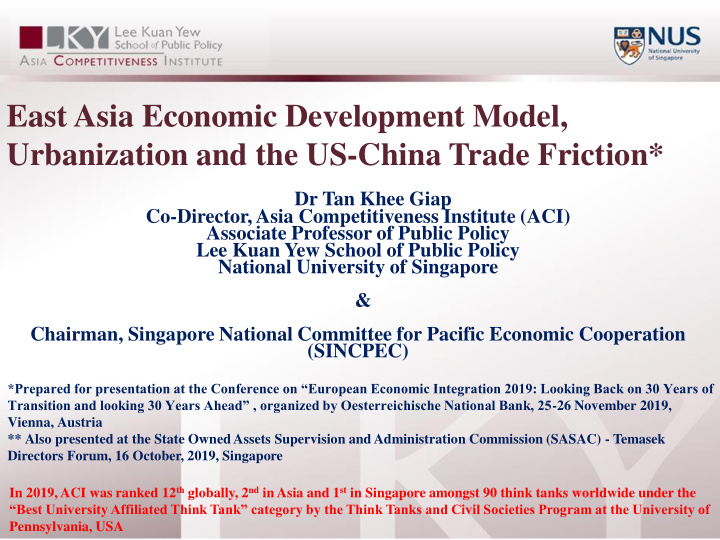



East Asia Economic Development Model, Urbanization and the US-China Trade Friction* Dr Tan Khee Giap Co-Director, Asia Competitiveness Institute (ACI) Associate Professor of Public Policy Lee Kuan Yew School of Public Policy National University of Singapore & Chairman, Singapore National Committee for Pacific Economic Cooperation (SINCPEC) *Prepared for presentation at the Conference on “European Economic Integration 2019: Looking Back on 30 Years of Transition and looking 30 Years Ahead” , organized by Oesterreichische National Bank, 25 -26 November 2019, Vienna, Austria ** Also presented at the State Owned Assets Supervision and Administration Commission (SASAC) - Temasek Directors Forum, 16 October, 2019, Singapore In 2019, ACI was ranked 12 th globally, 2 nd in Asia and 1 st in Singapore amongst 90 think tanks worldwide under the “Best University Affiliated Think Tank” category by the Think Tanks and Civil Societies Program at the University of Pennsylvania, USA
Presentation Outline 1. East Asia Economic Development Model: Resolving Three Bottlenecks 2. China-ASEAN Connectivity and Economic Integration: Let facts speak for itself 3. The Root, Nature and Impact of the US-China Trade Friction: It is a red herring! 4. Re-calibrating the One-Belt One-Road (OBOR) Initiative: Improving transparency, enhancing governance to promoting regional economic integration and convergence 5. P ragmatic Corporate Strategies for State-Owned Enterprises, can Singapore further partner China to co-invest in a third economy globally and can Singapore avoid having to choose side amongst major powers? 6. Four Hostile Foreign Forces, Four Underlying Concerns and Five Strategic Insistence and Prerequisites for China: Overall stability must prevail China’s Urbanization Drive and Technology Empowerment in the Era of Digital World 7. 8. ASEAN Smart Cities Network: High Quality of Life, Competitive Economy and Sustainable Environment 9. Asia Competitiveness Institute 2018 Global Liveable and Smart Cities Index 2
1 . The East Asian Economic Development Model: Resolving Three Bottlenecks 东亚经济发展模式 : 打 通 3 个瓶 颈 3
The Panoramic View of Flying Geese Model on Economic Development, Cooperation and Specialization 经济发展、合作与专业化的雁行模式全景 西方发达经济体(美国) 德国、日本 东亚新兴的工业化经济体(香港、新 加坡、韩国、台湾) 东盟四国和中国沿海 (中国沿海、印度尼 西亚、马来西亚、菲律宾和泰国) 中国西部、中部和东北,东盟转型经济体(柬埔寨、 老挝、缅甸和越南、中国西部、中部和东北) 4
The Flying Geese Model: Specialisation based on comparative advantage and cooperation 雁行模式 ( FGM ):基于经济比较与合作的专业化 • Japanese economists first used the Flying Geese Model (FGM) to describe waves of economic growth and development based on the transfer of comparative advantages between economies. 日本经济学家基于经 济体间比较优势的转移,首次使用雁行模式来形容经济发展的浪潮与发展 • Developed countries or regions tend to relocate their manufacturing and labour-intensive industries to developing countries or regions through international investment and trade, resulting in industrial restructuring and technological upgrading. 发达国家或地区倾向于将它们的制造业与劳动密集型工业通 过国际投资与贸易的方式迁 移至发展中国家或地区,这样做就引发产了业结构调整与科技升级 • 1950s: USA relocated steel, textile and other traditional industries to Germany and Japan, turning its focus on to developing semiconductor, telecommunication, computer and other emerging technology-intensive in dustries. 20 世纪 50 年代:美国将其钢铁、纺织等传统工业迁往德国和日本,并将其重点转移到发展 半导体,通讯,计算机等新兴技术密集型产业上 • 1960s to 1980s: Japan and Germany then shifted their low value-added, labour-intensive and resource-inten sive industries to East Asia’s NIEs, allowing them to focus on developing integrated circuits, precision mac hinery, fine chemicals, household appliances, automobiles and other high value-added technology-intensive industries. 20 世纪 60 年代至 80 年代:日本和德国将其附加值低的、劳动密集型与资源密集型产业向 东亚的新兴工业化经济体转移,使他们能够专注于发展集成电路,精密机械,精细化工,家电,汽 车和其他高附加值的技术密集型产业上 5
The Flying Geese Model (continued) 雁行模式 (接上页) • 1990s: Europe, Japan and the four Asian dragons gradually began to relocate those industries that were becoming less competitive in their own countries or regions to China's coastal regions and the ASEAN-4, namely Indonesia, Malaysia, Philippines and Thailand. 20 世纪 90 年代:欧洲、日本和亚洲四小龙逐渐将它们国 家或地区的竞争力较弱的工业转移至中国大陆的沿海地区与东盟四国,也就是印度尼西亚、马来西亚、菲律宾 和泰国 • After 2000: due to rising wages and higher land cost in the more developed economies of China’s coastal provinces, the Chinese government encouraged and incentivised multinational corporations (MNCs) to shift their high cost, high energy consuming, labour-intensive and environmentally taxing industries and production processes to the relatively undeveloped inland regions in order to regain international competitiveness and also to ensure a more balanced regional development. 2000 年后:由于中国大陆沿海省份经济体的工资上涨和 地价上升,中国政府鼓励和引导跨国公司 , 将它们高成本、高能耗、劳动力密集型与高污染工业或生产流程转 移 至相对落后的内陆地区,以便重获国际竞争力,并确保地区间的发展更加均衡 • This led to the domestication of the FGM: From international to domestic relocation of industries across regions in China. Meanwhile CLMV of ASEAN , namely Cambodia, Laos, Myanmar and Vietnam also began to use their natural and abundant low-cost labour resources to attract foreign companies to invest in manufacturing and technological components, replicating the East Asia export-oriented economies by engaging in international trade. 这就形成了雁行模式的本土化:从国际到中国国内地区间的工业转移。与此同 时,柬埔寨、老挝、缅甸和越南也开始使用他们的自然资源和丰富的低成本劳动力资源,吸引外国公司投资于 6 制造业和技术领域,通过参与国际贸易,复制东亚出口导向型经济体的发展 6
The East Asian Economic Development (EAED) Model 东亚经济发展模式 12 • The experience and success of the robust EAED model have shown that releasing production bottlenecks through compr ehensive planned investment to resolve infrastructure bottleneck is a prerequisite condition for economic take-off and a useful support for sailing through the middle income trap . 东亚经济发展模式的经验与成功已经揭示了全面打通基础 设施瓶颈进行投资规划以突破生产瓶颈是经济腾飞的先决条件和 顺利渡过中等收入陷阱的有力支持 • Most developing countries have weak budgetary conditions. Due to the relatively massive capital requirements, the long gestation period and the longer- term nature of returns on investment for infrastructure projects, cost of financing tends to be expensive and sources of funding are also in keen competition with other fund commitments, resulting in existing financing bottlenecks too. 发展中国家财政实力基础较弱。由于需要相对庞大的资金和较长时间的酝酿,以及基础 设施项目投资回报慢的本质,融资成本往往是高昂的,资金来源也需要与其他融资承诺进行激烈的竞争,这也导 致了现有的资金瓶颈 • Effective leadership and good governance clearly play a paramount role in harnessing and promoting infrastructure inves tment. For balanced, sustainable and inclusive regional economic and social integration, both physical and soft infrastruc ture provisions for greater connectivity are increasingly viewed as a form of regional public goods. 有效的领导和良好 的管理显然在治理和促进基础设施投资中扮演着十分重要的角色。对于均衡、可持续和包容性的区域经济和社会 融合,对于更好的连通性的实质的和非物质的基础设施规定都逐渐被视为区域公益的一种形式 • A longer-term roadmap for Asia-Pacific connectivity should be planned, and stronger economies which have comparative advantages in terms of capital, technology and competitive skills should play an active role in meeting pressing infrastructure bottlenecks which are causing growth inertia and imbalanced regional development. 一个对于亚太连通 性的长期路线图应当被计划和提出,并且在资金、技术和竞争技能方面具有比较优势的较强经济体应当对于突破基 7 础设施瓶颈发挥积极作用,因为这一障碍导致了增长惯性和地区发展失衡
Recommend
More recommend